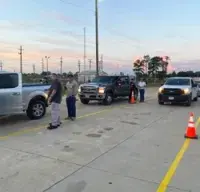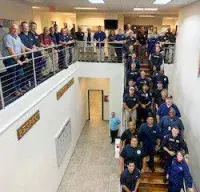 Security operations teams pose with the Port of Beaumont Facility security officer. (Photo courtesy of TSA Surface-Houston)
Security operations teams pose with the Port of Beaumont Facility security officer. (Photo courtesy of TSA Surface-Houston)
In the minds of American travelers, TSA is often synonymous with airports and aviation security. Most people don’t realize the agency is also responsible for security across the maritime and surface transportation landscape, including security operations not in the sky.
On Texas’ southern border, TSA Surface Operations from William P. Hobby Airport (HOU) is working to change the public – and other federal agencies’ – mindset about the scope of TSA’s mission. Their efforts culminated in a multi-partner, TSA-led Transportation Worker Identification Credential (TWIC®) security initiative known as Operation “Brass Triangle.”
Surface Inspectors from HOU field office worked tirelessly, strategizing and planning for six months, to host the largest multi-agency security inspection operation in history. The operation focused on TWIC card usage. TWIC is a Security Threat Assessment (STA) program, where TSA issues a biometric transportation security card to individuals requiring unescorted access to regulated facilities or vessels, after determining the individual is not a security risk. The TWIC program is jointly administered by the United States Coast Guard (USCG) and TSA.
The security operation involved partners from 11 agencies along with various state and local law enforcement. TSA and its partners verified and authenticated TWIC cards at regulated entities using the credential’s biometric and physical security features, as well as leveraging resources at TSA Headquarters to confirm the individual’s STA eligibility.
The synchronized operation involved 16 security components and ended with successful results. The group collectively performed 2,402 TWIC inspections, 604 vehicle inspections and 226 bag inspections in two days.
“It was necessary to develop and implement a comprehensive approach in concert with our joint, intergovernmental, interagency partners to achieve favorable outcomes,” said Brigid Baggerly, a Lead Surface Inspector and major supporter in event coordination.
Supervisory Transportation Security Inspector in Houston Bruce McClary-Davis echoed the same sentiments. As an event coordinator, he had three objectives in mind while planning: provide officers new experiences, foster friendships with the local law enforcement community and spread the word that all law enforcement agencies have an important mission, no matter how small their area of responsibility is.
“Because although we’ve [TSA] been around for 21 years, people still have misconceptions and don’t realize that TSA is so much broader than just the aviation community.”
The security operation lifted a curtain to reveal an extensive network of partner agencies that organizations have outside their office walls. Before participating in the event, these partner agencies might not have seen their security responsibilities as overlapping or collaborative.
Mamie Kinzig, Special Agent in Charge of the Dallas, Texas TSA Investigations Office said, “The dedicated men and women of DHS work tirelessly behind the scenes to ensure the safety of our airports, seaports, railways and waterways. Dallas TSA Investigations was proud to be part of such an important event partnering with TSA Surface Operations and the USCG. This TWIC operation was a shining example of partnerships built among multiple agencies, and sets the precedent for future interagency collaboration. Whether it was attending 4 a.m. briefings, slathering on insect repellant and braving long hours in humid conditions, our law enforcement partners stood ready to serve.”
The security operation revealed that the transportation security community is part of a greater mission, and when incidents occur, the community can rely on each other for support and success.
“Marine Safety Unit Port Arthur and TSA Houston have been collaborating for several years on operations, with a steady increase year to year,” said USCG Lieutenant Mark Velez. “This collaboration led to other DHS agencies, such as HSI and CBP, to take notice. They have been supporting the event pretty regularly, especially since we restarted operations after COVID. This year’s operation brought together agencies I didn’t even know were part of the DHS community.”
These established open lines of communication were a major win for organizers. In an effort to maintain these new relationships, organizers are already planning for more frequent, future events.
“We have to make sure that people understand that as soon as you leave your house, there's someone out there,” said McClary-Davis. “If your kids are going on the school bus, if you're getting on a cruise ship, if you're going fishing, if you're going into a chemical plant that's associated the waterway system, there are layers and layers and layers of security in place that you may or may not see. And so we just want to make sure that everyone understands that we are part of that layer in regards to TWIC enforcement.”
Lieutenant Velez reflected on the event’s success, saying, “Since the operation, I have maintained contact with members of several agencies on a weekly basis. You can’t build these types of relationships unless you’re out there, elbow-to-elbow doing the mission at 4 a.m. in 100% humidity, eating donuts with bacon on top.”
By Kimberlyn Pepe, TSA’s Strategic Communications & Public Affairs


